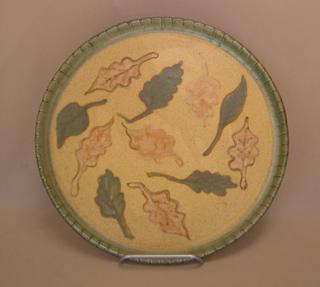

I want to post a few pictures from my Oct. 9 glaze firing (^7ox). In one of my earlier entries I was wailing about how my favorite iron red glaze was not coming out right. Well, it turns out this glaze likes a soak on the way down at about 1600 for several hours . I learned this from John Hesselberth on "Clayart". Another Clayart member, Tom Buck clarified some of the reasons for a "muck" olive color replacing the red ...overfiring most likely. Anyway, the top photo shows 3 pieces which I redipped and refired- they are much improved. The mug was not a refire, and shows a decent color too. (the turquoise mug is there to make the other one look redder, haha. I didn't know the handle on the red one was so "sturdy"!!- someone else must have sneaked into my studio and attached that one. Feels OK, though.
At the suggestion of Dannon Rhudy, I tested adding a little bone ash to this glaze and sure enough, a side by side test looks promising enough to try a larger amount next firing.
 This is an 11" plate. As is the following one of gourds.
This is an 11" plate. As is the following one of gourds.
This next one is an 18" tray. It turned out to be somewhat of a "spinner". Well, hey, is that all bad? It's big enough for me to call it a lazy susan-done intentionally, of course!


2 comments:
Hi Ann,
I use an Iron Red that looks just like yours, and I have found that glaze thickness also has alot to do with how much red you get. It seems, with my glaze, the thicker the better. And, it's great because it doesn't run! I believe the recipe is very similar to Randy's Red:
flint 26
epk 4
iron ox. 18
GB 28
f-4 spar 18
talc 12
you can see pix of my red at:
www.sheaclay.com
have a beautiful day!
tracy shea
Hi Ann,
That red glaze is working nicely for you now.... I 'll bet you could get some mileage out of how the glaze breaks black on the edges. That characteristic would really emphasize design elements !
Nice Work.
Colleen
Post a Comment